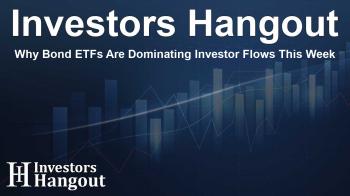Why Bond ETFs Are Dominating Investor Flows This Week

Bond ETFs Lead the Pack in Market Inflows
Recent data showed that U.S.-listed ETFs attracted nearly $19 billion during a recent week, with fixed-income investments taking the lion's share. Specifically, bond ETFs drew an impressive $15.3 billion, significantly overshadowing the $2.2 billion allocated to equities. This trend underscores a broader shift towards defensive investment strategies as the market anticipates potential rate cuts by the Federal Reserve.
Insights into Rate Cut Expectations
Market sentiment is increasingly leaning toward the idea that the Federal Reserve might ease monetary policy soon. Analytics from futures markets indicate a staggering 94% likelihood of a quarter-point rate cut on the horizon. Investors are beginning to position themselves accordingly, particularly gravitating toward fixed-income assets like short-term Treasuries, which are anticipated to benefit from lower rates.
The Rise of Short-Duration Treasury ETFs
Among the standout performers in the fixed-income space are the iShares 0–3 Month Treasury Bond ETF (SGOV), capturing $2.3 billion, and the SPDR Bloomberg 1–3 Month T-Bill ETF (BIL), which attracted $1.6 billion. Investors are increasingly utilizing these funds to manage cash effectively while minimizing interest rate risk. As cash management tools, these ETFs offer liquidity and stability while providing competitive yields in a high-rate environment.
Equity ETFs Still on Investors' Radar
While bond ETFs are grabbing the spotlight, certain equity ETFs are also experiencing notable inflows. The Communication Services Select Sector SPDR Fund (XLC) has emerged as a leader among equity products, drawing in $3.8 billion as investors remain optimistic about major players like Meta Platforms Inc (META) and Alphabet Inc (GOOGL). This sector's ongoing strength is attributed to robust advertising revenue and growth prospects fueled by artificial intelligence.
Market Conditions Favoring Defensive Strategies
Investor preferences for bonds over equities highlight a shift towards caution amid various market challenges. Major stock indices are trading near historical peaks, yet geopolitical uncertainties, uneven economic indicators, and inflation concerns loom large. The anticipation of a rate cut by the Fed implies a shift from a stringent policy framework that has prevailed for over two years. Such a change could facilitate a more favorable borrowing environment, supporting riskier assets even as the Fed signals a need for growth amid emerging economic pressures.
In this landscape, short-duration Treasuries and other similar low-duration strategies appear prudent for achieving desirable yields while maintaining the flexibility for portfolio adjustments if market conditions evolve.
If the anticipated rate cut occurs, longer-duration fixed-income ETFs may witness substantial price appreciation, while equities could receive a boost from falling discount rates. Conversely, if the Fed maintains its current stance, market movements could reverse promptly, underscoring the event-driven dynamics shaping current portfolio strategies.
Frequently Asked Questions
What are the recent trends in ETF inflows?
Recently, bond ETFs have significantly outperformed equity ETFs in attracting investor capital, reflecting a shift in market sentiment towards more defensive investments.
Why are investors focusing on bond ETFs?
The expectation of potential interest rate cuts by the Federal Reserve is prompting investors to seek the stability and liquidity offered by bond ETFs, particularly short-duration ones.
Which bond ETFs are currently popular among investors?
The iShares 0–3 Month Treasury Bond ETF (SGOV) and the SPDR Bloomberg 1–3 Month T-Bill ETF (BIL) are leading in inflows, showcasing their appeal for cash management and lower interest rate risk.
How are equity markets reacting in this climate?
Despite the dominance of bond ETFs, some equity ETFs also attract significant inflows, particularly in sectors driven by technology and strong revenue growth.
What could happen if the Fed announces a rate cut?
If the Fed executes a rate cut, longer-duration fixed-income ETFs may experience price gains, and equities might also receive renewed support from lowered discount rates.
About The Author
Contact Lucas Young privately here. Or send an email with ATTN: Lucas Young as the subject to contact@investorshangout.com.
About Investors Hangout
Investors Hangout is a leading online stock forum for financial discussion and learning, offering a wide range of free tools and resources. It draws in traders of all levels, who exchange market knowledge, investigate trading tactics, and keep an eye on industry developments in real time. Featuring financial articles, stock message boards, quotes, charts, company profiles, and live news updates. Through cooperative learning and a wealth of informational resources, it helps users from novices creating their first portfolios to experts honing their techniques. Join Investors Hangout today: https://investorshangout.com/
The content of this article is based on factual, publicly available information and does not represent legal, financial, or investment advice. Investors Hangout does not offer financial advice, and the author is not a licensed financial advisor. Consult a qualified advisor before making any financial or investment decisions based on this article. This article should not be considered advice to purchase, sell, or hold any securities or other investments. If any of the material provided here is inaccurate, please contact us for corrections.

